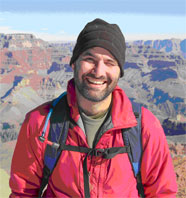Arizona Geological Society
2024 Speaker Series
Tuesday, 2 April 2024 | 5:30 - 8:00 PM
Location: Hexagon Mining Division Office
40 East Congress Street, Suite 150, Tucson, Arizona 85701
Parking: On the street or parking garage (Old Pueblo Parking)
Social Hour with Sandwiches from Beyond Bread (5:30-6:30 PM), Presentation (6:35 PM)
For those planning to attend the event, please register by 6:00 PM on Sunday, 31 March, 2024
For those unable to attend, here is a
MS Teams URL for Remote Viewing
Remote Broadcast begins at 6:35 PM
Streaming URL Link
Join the meeting now
Meeting ID: 338 104 363 602
Passcode: hDQDQz
The Arizona Geological Society also thanks Hexagon
for generously providing the venue and drinks
Basin Evolution, Deformation, and Mineralization in Big Sandy Valley, Northwestern Arizona
Brian F. Gootee and Carson Richardson
Arizona Geological Survey
Abstract: Big Sandy Valley in northwestern Arizona is a large, exceptionally well-exposed extensional basin with complex Proterozoic bedrock, multiple Laramide porphyry stocks, the Miocene Kaiser Spring volcanic field, two generations of Miocene to Pliocene basin fill, interbedded rock-avalanche deposits, and middle Miocene and younger faults. Systematic geologic mapping in this basin was initially motivated by several factors: ongoing copper and lithium exploration, 3D structural and stratigraphic controls on mineralization and groundwater, and U.S. Hwy 93/Interstate 11 infrastructure.
Proterozoic rocks in the Hualapai Mountains were intruded by the Cretaceous Wikieup, Diamond Joe, and Wheeler Wash stocks with associated (but variably developed) porphyry alteration. A fourth Laramide stock near Devil’s Canyon is not exposed, and instead a monzonite to quartz monzonite porphyry dike swarm is present.
A poorly exposed, east-dipping, low-angle normal fault is present along the eastern margin of the northern Hualapai Mountains. This fault is not exposed farther south near the Diamond Joe pluton, but the Big Sandy prospect has rocks of the same composition and age and is interpreted as the faulted top of the Diamond Joe pluton transported ~13 km to the ENE (Bell Copper, 2021). Still farther south, a moderately ENE-dipping normal fault is exposed near the Wikieup pluton and may be the southern continuation of this same fault. Thermochronologic cooling ages (AHe, AFT, and ZHe) of the major plutons suggest rapid middle to late Miocene exhumation of the Hualapai Mountains, while Late Cretaceous to Paleogene cooling ages (ZHe and AHe) of a Cretaceous dike in the Aquarius Mountains suggest the Aquarius Mountains were a structurally higher level of the crust during that time.
The oldest basin-fill deposits, informally called the Tule Wash beds, are a sequence of limestone, basalt, mudstone, sandstone, and conglomerate lithofacies up to 1,500-2,000 m thick. In northern Big Sandy Valley the depositional axis of the Tule Wash basin was located on the far eastern side of the valley, as indicated by multiple interbedded rock-avalanche breccia-flows sourced from the Hualapai Mountains. Across much of the valley width the Tule Wash beds are predominantly W-tilted into E-dipping faults; along the Aquarius Mountains the dip polarity flips into generally ENE-tilted fault blocks cut by N- to NW-striking faults with major WSW-side-down slip. After deposition and deformation of the Tule beds, a basin-wide erosional event formed an angular unconformity over the Tule Wash beds; eroded Tule Wash deposits were transported south to an unknown depocenter. In the southeastern Aquarius Mountains, the ~15-8 Ma Miocene Kaiser Spring volcanic field, a bimodal complex assemblage of felsic lava domes, mafic lava flows, breccias, and pyroclastic rocks, was emplaced over an eroded crystalline bedrock surface that also overlapped with Tule Wash deposition and deformation.
Flows from the Kaiser Spring volcanic field blocked the southern exit from Big Sandy Valley, forming a closed basin between ~10-5 Ma. This basin was filled by the Big Sandy Formation, a basin-wide fanglomerate, sandy, muddy and carbonate assemblage. Lithium mineralization near the community of Wikieup is hosted within the muddy lithofacies of the Big Sandy Formation, but the source rocks and mechanism of lithium mineralization remains debated. By ~5 Ma, the Big Sandy Formation aggraded with sediment and water to a maximum floor elevation of ~750 m above sea level at its southernmost terminus and spilled across crystalline bedrock where the northern Poachie and southern Hualapai Mountains meet. Since then, Big Sandy Valley has undergone erosion with a series of off-lapping alluvial terraces cut into older basin fill deposits. Though Big Sandy Formation is largely undeformed, one fault zone on the west side of the valley offsets late Pleistocene and older deposits.
Bio: Brian Gootee is AZGS’ Chief of Basin Analysis. He received his B.S. and M.S. from Arizona State University.
Carson Richardson is AZGS’s Chief of Mineral Resources and Bedrock Geology. He received M.S. and Ph.D. from the University of Arizona.



Hexagon Mining Division Office - 40 East Congress Street,
Suite 150, Tucson, Arizona 85701